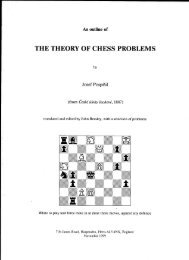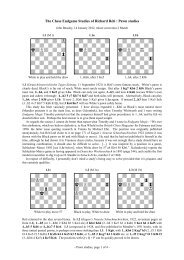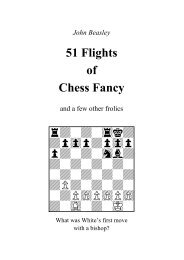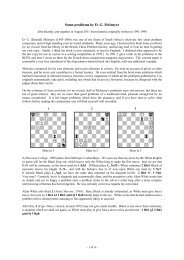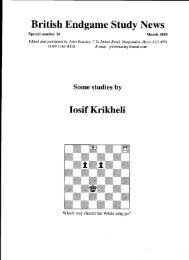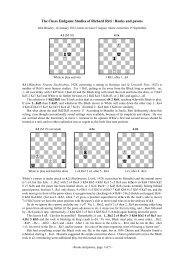A tribute to G. W. Chandler - John and Sue Beasley
A tribute to G. W. Chandler - John and Sue Beasley
A tribute to G. W. Chandler - John and Sue Beasley
Create successful ePaper yourself
Turn your PDF publications into a flip-book with our unique Google optimized e-Paper software.
Two-movers 11<br />
1 (2nd Prize, Western Daily Mercury, 1909). The set check 1...Rf4+ is met in<br />
good style by 2 Bf6, the other set check 1...Rf3+ more crudely by 2 gxf3.<br />
However, flight-creating moves such as 1...Bxa3 need attention, suggesting a<br />
threat which covers d3 as well as e4, <strong>and</strong> 1 Qe8, threatening 2 Qg6, is among the<br />
few moves <strong>to</strong> provide one. It gives two more cross-check lines, 1...c4+ 2 d6 <strong>and</strong><br />
1...cxd4+ 2 Bd6, while 1...Ne3 2 d3 <strong>and</strong> 1...Ng3 2 Re3 provide a further pair of<br />
neat mates. It all makes a very attractive blend.<br />
2 (La Stratégie, 1909, version). Black has no obviously strong move here, but<br />
several harmless moves are available <strong>to</strong> him. So we need a threat, <strong>and</strong> 1 Ke1<br />
(threat 2 Rf1) makes one of the few which cannot immediately be defeated.<br />
Black’s checks can be met (1...Bb4+ 2 Bc3, 1...Re5+ 2 Be3), <strong>and</strong> the only other<br />
lines are 1...c5 2 Qc7 <strong>and</strong> the crude 1...Rxf5 2 Qxf5. In the version in <strong>Ch<strong>and</strong>ler</strong>’s<br />
scrapbook, the Black bishop is on h5, which gives the threat rook something else<br />
<strong>to</strong> do (1...Bxg4 2 Rxg4) but allows the cook 1 gxh5. The present version uses the<br />
rook only for the threat; would <strong>Ch<strong>and</strong>ler</strong> have approved its publication? I suspect<br />
that he might not, but the two cross-check lines seem <strong>to</strong> me <strong>to</strong> be worth the cost.<br />
3 (Pittsburg Leader Tourney, 1910). The only plausible threat is along the<br />
bot<strong>to</strong>m line, <strong>and</strong> 1 Kb5 threatens 2 Qa1 but gives Black three checks: 1...Qxb7+<br />
2 Bb6, 1...Qh5+ 2 Bg5, <strong>and</strong> 1...f1Q+ 2 Nc4. The <strong>to</strong>urney judges described this as<br />
“a pleasing cross-checker with a spicy key”, but were sharply critical of the use of<br />
the Black rook <strong>and</strong> the knight at b8 just <strong>to</strong> prevent the dual-allowing move 1...Qf8.<br />
However, avoidance of duals even after non-defensive moves was characteristic of<br />
the English style of the time. Nowadays we would omit the pawn on g7 as well.<br />
4 (1st Prize, Manchester Weekly Times, 1910). The check 1...Rxc5+ <strong>and</strong> the<br />
flight-creating move 1...d2 are met by simple captures, <strong>and</strong> we have no real clue<br />
except the out-of-play men on the a-file. Without that rook, we could mate at a1;<br />
does this suggest the splendid 1 Rh2? The thematic defences bring a Black man <strong>to</strong><br />
d6, obstructing the diagonal from f8 <strong>and</strong> tying the White queen <strong>to</strong> the defence of<br />
c5, but each obstructs Black as well: 1...Rd6 2 Rh4 (this is why only Rh2 will do<br />
for the key), 1...Bd6 2 Ne6, <strong>and</strong> 1...Nd6 2 Bg7. A minor line is 1...Nb5 2 Qxb4.<br />
5 (Op de Hoogte, February 1913). The moves freeing c3 can all be met, as<br />
we shall see, but 1...Nxg6 (freeing d3) needs attention <strong>and</strong> 1 Qh8 provides it<br />
(1...Nxg6 2 Qd8). The threat is 2 Qh4, <strong>and</strong> now the Black rook comes in<strong>to</strong> its<br />
own: 1...Rb3 2 Rxc4, 1...Rd3 2 Rf5, 1...Re3 2 Rf4, <strong>and</strong> 1...Rxf3 2 Rxf3.<br />
Another nice <strong>to</strong>uch is 1...Nc5 2 Rd6. It is not a typical work, but the matched rook<br />
moves 1...Rd3/Re3/Rxf3 2 Rf5/Rf4/Rxf3 have a definite appeal.<br />
6 (4th honourable mention, Brisbane Courier, 1918). There is no prominent<br />
Black move <strong>to</strong> be met (the flight-creating 1...d3 allows 2 Qg4) but how can we<br />
create a threat? A move of the rook on f5 might do it: 1 Rh5, taking over the<br />
guard of f5 <strong>and</strong> threatening 2 Bc6. Every move of the Black knight on c4 defeats<br />
this threat (1...N-- 2 Bc6+ Bd5), but a nondescript move such as 1...Na5 allows<br />
2 Qc2 exploiting the pin of the pawn on d4, <strong>and</strong> three attempted correction moves<br />
also fail: 1...Nb2 2 Nc3 <strong>and</strong> 1...Nd2 2 Qxe3 exploiting the pin, <strong>and</strong> 1...Ne5 2 Bf5<br />
exploiting the self-block on e5. This was a theme <strong>to</strong> which <strong>Ch<strong>and</strong>ler</strong> would return.



